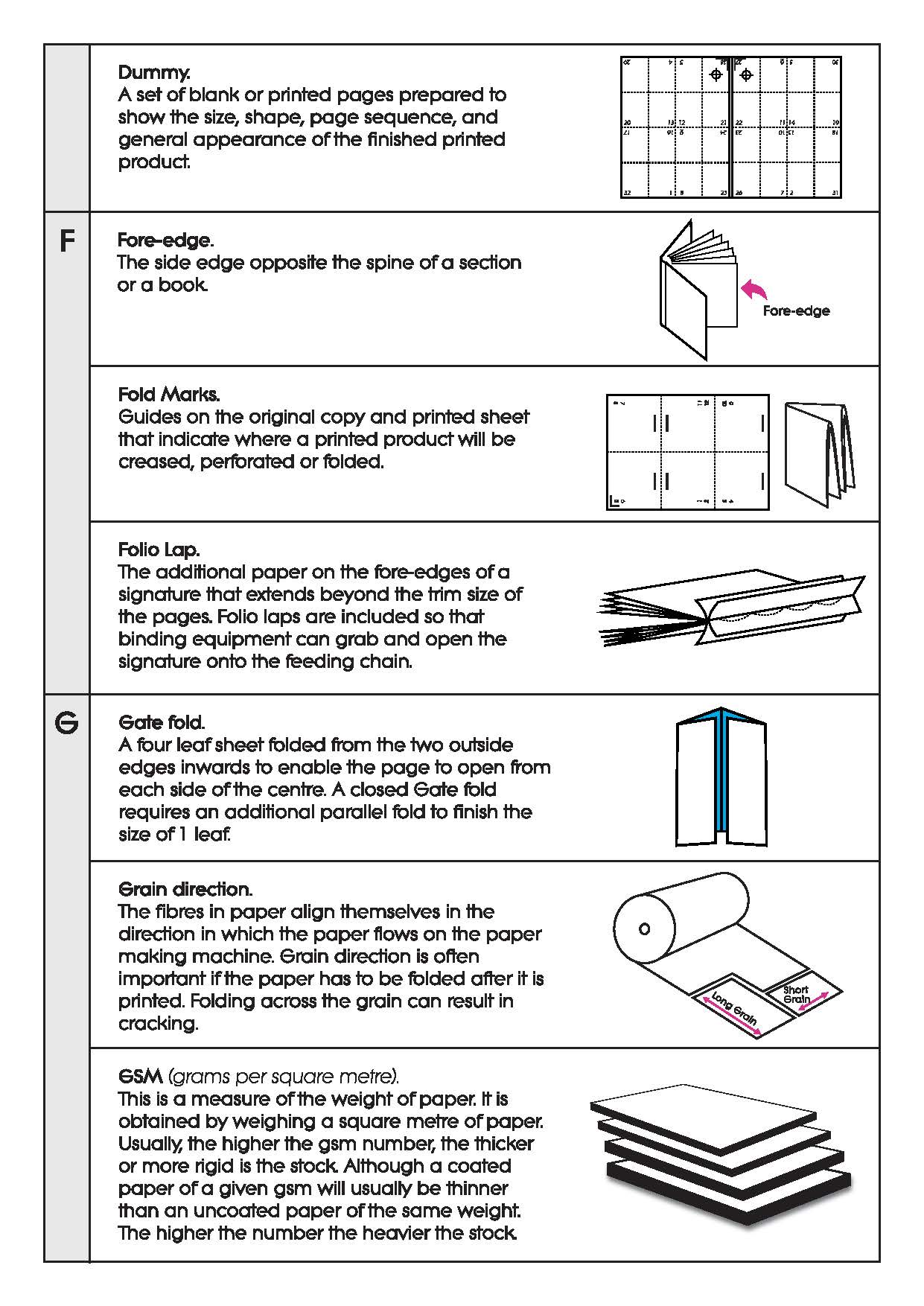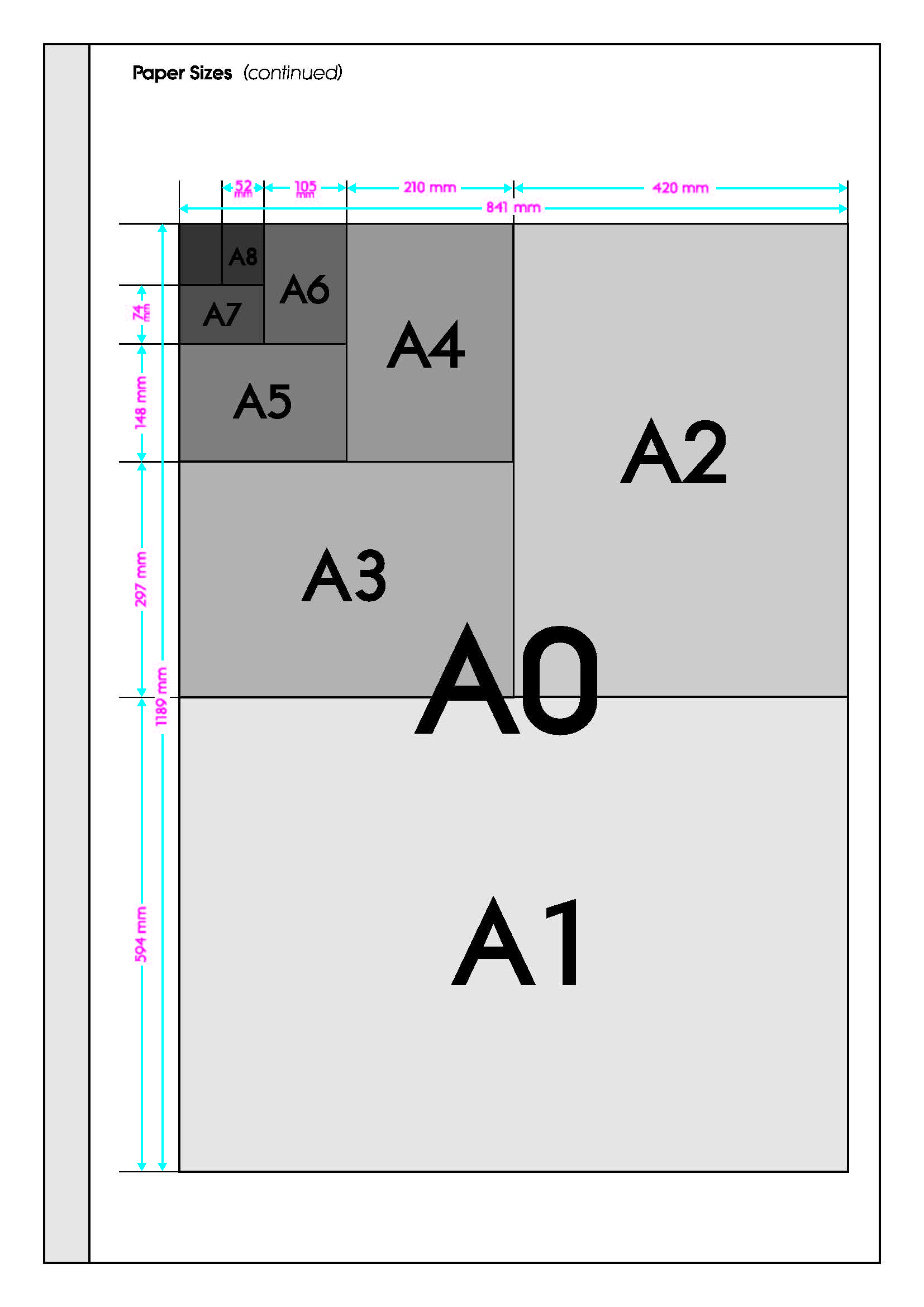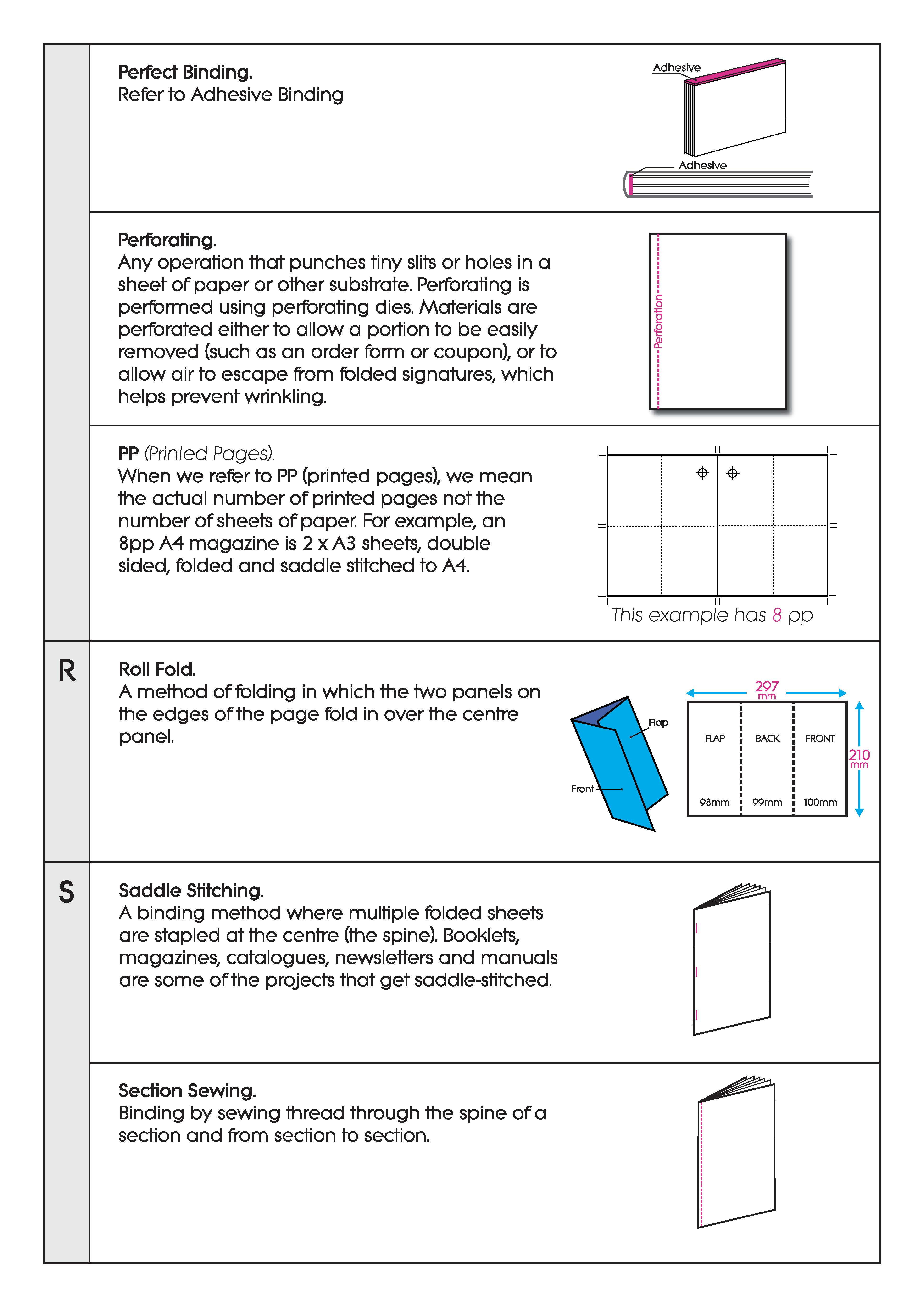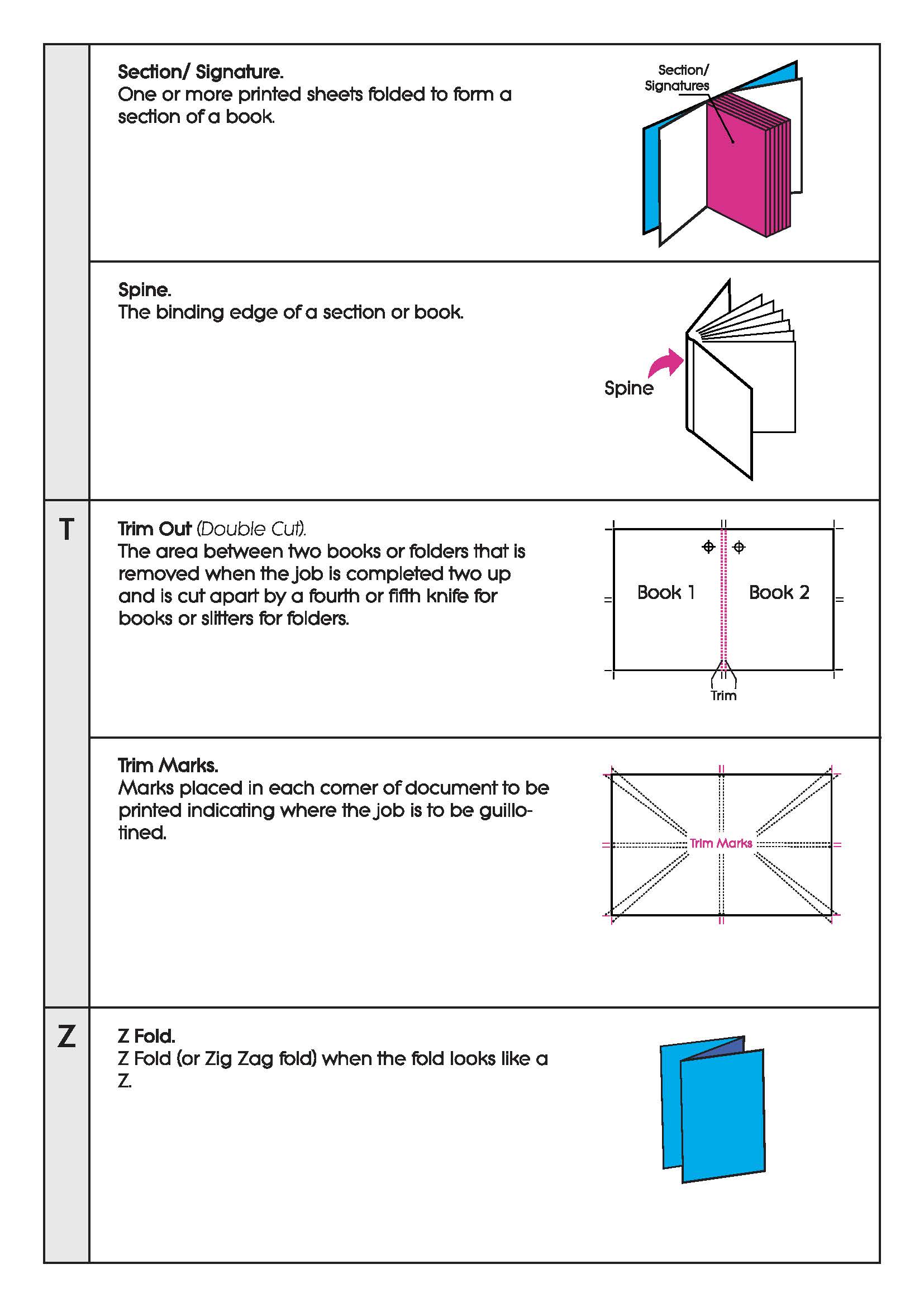Glossary
We have put together a collection of commonly used printing terms, that will hopefully provide helpful definitions.
#
1-UP
Artwork that has been supplied 1-up has not been imposed. This means that each printed page is a separate page within the artwork file. When two pages are supplied on the same page in an artwork file, this is considered to be imposed or 2-up.
A
ARTWORK
All copy, including type, photos and illustrations, intended for printing. As a general rule, artwork should be supplied as a high resolution PDF at 300 dpi, with crop marks and 3mm bleed.
B
BACKING UP
Backing up means printing on the second side of a sheet that has been printed on one side. It can also mean adjusting artwork on one side of a sheet so that it aligns back-to-back with the artwork on the other side.
BINDING
Binding is the joining of paper sheets together to form a book or booklet with staples, wire, glue etc.
BLEED
Bleed is a printing term that refers to printing that goes beyond the trim edge of the sheet or page. In other words, the bleed is the area to be trimmed off. Artwork and background colours can extend into the bleed area. After trimming, the bleed ensures that no unprinted edges occur in the final trimmed document. For more info about bleed check out our Artwork Guidelines.
BURST BINDING
Burst binding is a type of Perfect Bind where the binding edge of folded sections have been ‘notched’ instead of pretrimmed, creating a strong bite for the adhesive.
C
CARBONLESS PAPER (NCR)
Paper coated with chemicals that enable transfer of information from one sheet to another with pressure from writing or typing. NCR is an acronym for No Carbon Required.
CASE BINDING
Case binding is the method of binding used for hardcover books. This is the most expensive method of bookbinding but is also the most professional looking.
CAST COATED
Art paper with a exceptionally glossy coated finish usually on one side only.
CELLOGLAZE
Celloglazing is the thermal application of a super thin laminate film which is lightweight and flexible, making it suitable for book covers, business cards, menus etc. Available in matte or gloss it is a luxurious and durable finish to any item.
CMYK
Abbreviation for cyan, magenta, yellow and key (black), the four process colors.
COMB BINDING
This binding method uses a piece of plastic (the comb) that fits into punched rectangular holes in the paper. It is slightly less expensive than spiral binding and is great for manuals and books that need to lay flat when open. NB pages cannot be opened 360 degrees as they can with spiral binding.
CROP MARKS
Crop marks or trim marks are printed lines showing where to trim a printed sheet.
D
DIGITAL PRINTING
Short runs of any quantity are typical for digital printing. As a digital printer requires no printing plates, there is less time and expense involved in setting up a file to print. This means that a finished file can be proofed and final quantity run within a short time period.
DIGITAL PROOF
A PDF of the finished print produced for customer inspection for errors to be corrected prior to mass printing.
DISPLAY TYPE
Larger type used for headings etc. Normally about 18 point or larger.
DPI (Dots Per Inch)
DPI is a measurement of resolution of a printed image as determined by the number of dots that fit into one inch. The higher the concentration of dots per inch, the sharper the image will be.
E
EPS
EPS stands for Encapsulated PostScript and it is a file format widely used by the printing and graphics industries.
F
FINISHING
Any process that occurs after printing. This includes trimming, folding, stitching, binding, laminating etc.
FINISHED SIZE
Size of product after production is completed, as compared to flat size. Also called trimmed size.
FLAT SIZE
Size of product after printing and trimming, but before folding, as compared to finished size. Can also be used if a product is to be supplied scored (creased) but unfolded.
FOLIO (page number)
The actual page number in a publication.
FOUR COLOUR PROCESS
Printing artwork using the four basic colours of ink (cyan, magenta, yellow, black).
FULL COLOUR
Or 'four colour process' using the four basic printing colours: cyan, magenta, yellow and black.
G
GREYSCALE
Shades of grey ranging from black to white.
GUSSET
Expandable portion of a pocketed folder or envelope.
I
IMPOSITION
Positioning pages in a press-ready form so that they will be in the correct numerical sequence after folding. Impositions are created using specialist printing software. Please do not create impositions of your artwork - always supply artwork as one page per page.
L
LEAF
One sheet of paper in a publication. eg 1 leaf = 2 pages.
O
OFFSET PRINTING
Offset printing uses CMYK (Process or Full Colour) and Pantone spot colour (PMS). This process uses ink and plates to transfer an image onto paper. It produces high quality cost effective results for long print runs.
OSO
A printing abbreviation for One Side Only.
P
PANTONE COLOURS (PMS)
Premixed ink colours that are often specified for printing as a spot colour. can be matched using CMYK but will not be exactly the same colour as its Pantone colour counterpart.
PBS
A printing abbreviation for Printed Both Sides.
PERFECT BINDING
Perfect binding is the binding method that is used on most soft cover and paperback books. Perfect binding uses a flexible adhesive to join pre-trimmed collated pages to the wraparound cover, which then acts as the front, back, and spine of the book.
PROOF
A hard copy representation of the finished print produced for customer inspection for errors to be corrected prior to mass printing.
R
RESOLUTION
The number of dots per inch (dpi) in a computer-processed document. Artwork needs to be supplied at 300 dpi to ensure that it prints sharply without pixelation.
S
SADDLE STITCHING
The quickest, most cost effective form of binding for producing booklets that are around 60 pages or less. Two or three staples are inserted along the folded edge of the pages (spine) to create the book. Saddle stitched books have the advantage of being able to be laid open flat.
SCORING
Scoring is the process of pressing a channel or crease into a sheet of paper to allow it to fold more easily. Scoring is important because it prevents the ink (and paper) from cracking at the edge of the fold.
SIDE STITCHING
Side stitching is a form of binding used on thick publications eg manuals. It involves running a staple through the collated pages, and then wrapping the document with a cover that is adhered to the spine. It is very strong, but has the disadvantage that it can’t be laid open flat.
SPIRAL OR COIL BINDING
Spiral binding is a cost effective binding method that is done by running a plastic coil through predrilled holes made in the book. This method of binding allows the book to lie completely flat when open and also allows the pages to rotate 360 degrees to make it easier to hold while reading. This binding method is great for workbooks, presentation materials, and manuals. Adding a plastic cover to your book will provide durability.





